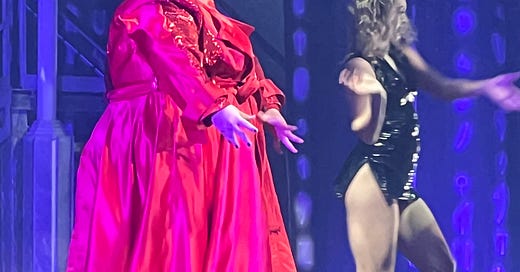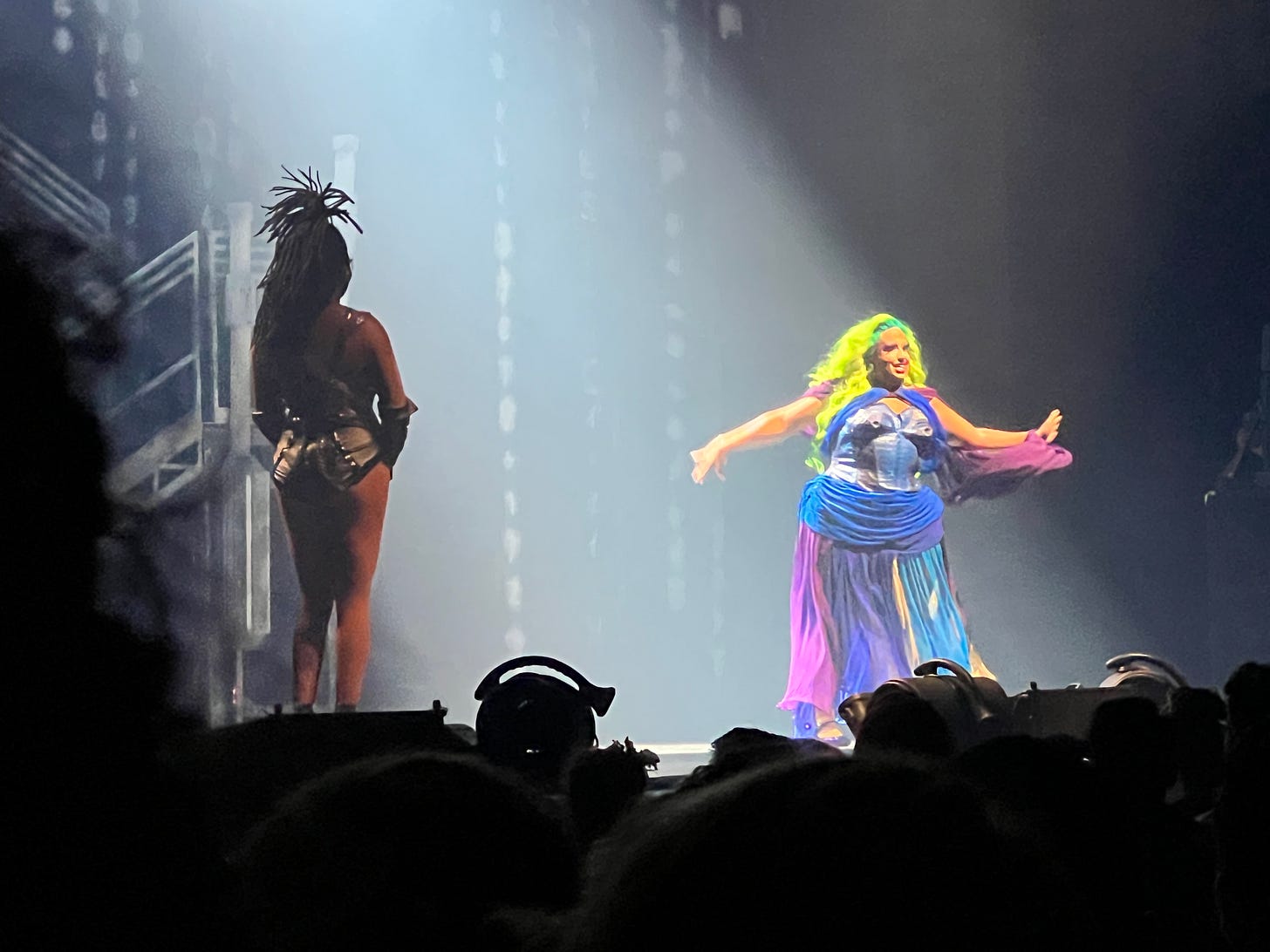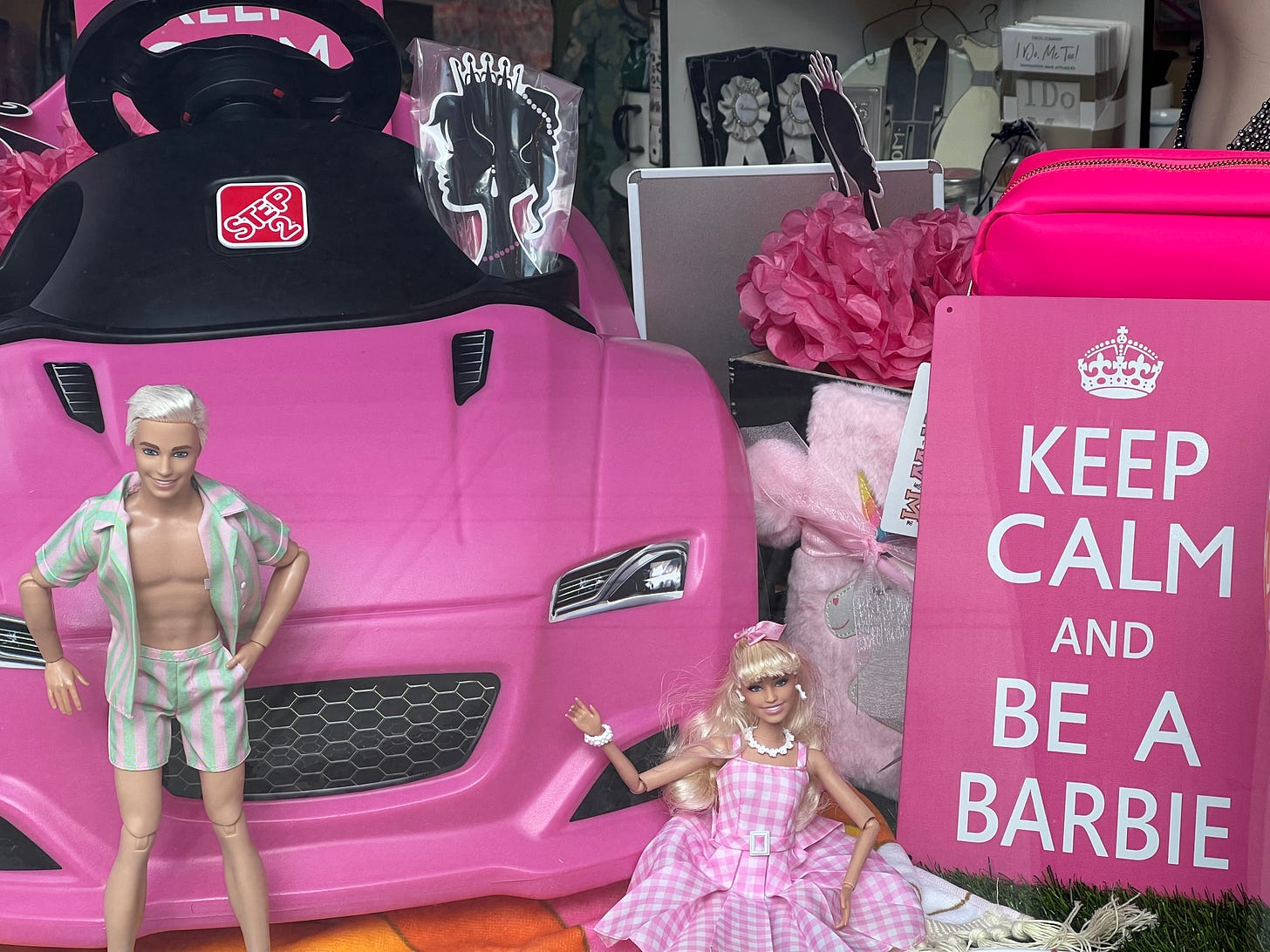Outside on a hot summer night, people are milling, waiting for the show to begin. Young and old. Black and white. Middle aged straight couples and clusters of gay men. Attractive young people, and unattractive young people. People in various degrees of cosplay. The fashion choices include pink everything, rainbow shorts, and a certain amount of black leather. The excitement is palpable. People have been waiting for this for a very long time.
The next day, at a different venue, at a different show entirely, the only element missing is the black leather.
I went to both events as an anthropologist, stepping into parts of American culture with which I had no prior experience. While anthropologists never want to call attention to their otherness, it is generally impossible to conceal the fact that you are other when you drop in from what might as well be outer space. When I lived in Madagascar, where I was not anthropologist but biologist, I was the focus of endless attention. Children followed me, the bravest among them racing up to touch my skin and my hair, even the shy ones pointing and shouting “vazaha!” as I walked down the street. White person! It wasn’t cruel. It wasn’t dangerous. They just had never seen anything like me before. They wondered what I was, as it was obvious to them that I wasn’t the same as what they were.
On a Saturday night in Portland, Oregon this week, I went to Keller Auditorium for the “Werk the World” show put on by the juggernaut that is RuPaul’s Drag Race. Unlike an actual anthropologist, I had—intentionally—come entirely unprepared. I have never seen an episode of RuPaul’s Drag Race. I barely know what it is—don’t really know the conceit, certainly don’t know the players, and most definitely do not know the culture that has bubbled up around it. I wanted to see the show without having heard anything in advance about what other people thought, and to see it as a stand-alone event.
The next day, I went to see Barbie, the movie.
The similarities were striking.
Everything has become spectacle. Before showtime at the Keller auditorium, the music is intense, booming, distorted, at least this close to the stage, in the shadow of massive speakers. Beams of red light sweep over the crowd, and the giant screen has digital drag dystopia on endless repeat. Finally, the show starts: a short, high energy dance number with a dozen drag queens, people wearing personas that are known by a large fraction of the audience. These queens are famous. But they’re famous in the way of all reality TV stars—famous for being famous, and for some exaggerated aspect of their personalities.
The show is primarily a series of dance numbers, most with a single central drag queen, plus six accessory dancers, two women, and four men. The accessory dancers are excellent at what they do, and they work hard. Hopefully the gig pays well. Most modern dance doesn’t, I think, involve quite so much twerking and writhing and grabbing of crotches.
Whenever a new act comes on stage, the audience screams in ecstasy, like so many teenage girls. Some of the drag queens have moves, to be sure. A few of them are beautiful even, at least from this distance. Asia, our host for the evening, is among them.
But the audience screams especially hard for the obese drag queens. The obese drag queens have rolls of fat, and when they jiggle their fat suggestively, the audience roars its approval. When they grab their own crotches, they get more screams. When they make suggestive movements with their tongues, more screams. When one of them—improbably, and impressively—does the splits, the response is nearly ear-shattering. Other than that one move, though, the obese drag queens demonstrate little in the way of skill. And yet they are adored.
After intermission, two amateur drag queens are brought on-stage from the audience. They are going to lip sync—For Your Life! It’s a competition, which the audience will judge. The first queen is polished and immaculately put together, with tall black boots so elaborate that Asia comments on them approvingly. He’s a tall leggy Brazilian with long, perfectly straight blond hair, and lip syncs well to a song he didn’t know was coming. He also knows how to move. The second one does not have the moves, and mostly fails to lip sync at all while jiggling his bits. He is also obese, and what he has in addition to his fat is the presumption that people will love him. He is right. They do. The audience overwhelmingly gives him the win. Objectively, he wasn’t nearly as good as the first guy. But that presumes that I understand what the game is. Clearly, I do not.
The obese amateur drag queen does know the game, though, and plays it well. Or rather, he werks it. He does it so well that I know his name—“Karisma with a K”—but do not know the name of the more skillful queen who lost. The game, I guess, is about being something so loud, and so brash, that others will fall all over themselves to demonstrate their adoration of you. Loudness, and brashness, and simply not being as you’re expected to be, is now sufficient to earn adulation, if you choose to claim that ground. It’s a way of telling the system off, without having to have any clarity about what the system is, or why you’re angry at it in the first place.
Karisma-with-a-K earns a solid “you go girl!” vibe from the audience.
“You go girl” would seem to be a statement of female empowerment. I’m not convinced. It seems to me, at best, to be a celebration of that which is immutable, those things that you did not earn, and did nothing to change. At worst, it’s a celebration of poor choices, and unfortunate outcomes.
In Barbieland, too, everything is spectacle. It’s a movie so pink, it caused a global shortage of pink paint. As with Werk the World, I am neither the intended audience, nor familiar with the universe from which the confection emerges. Once, when I was little, a well-intentioned family member who was unaware that I had no interest in dolls gave me a Barbie as a birthday present. She had loved her Barbies, and assumed that I would, too. I put the box politely aside and never saw the thing again.
That said, much of the movie is entertaining and fun. Not deep, and not dark, but then, it doesn’t pretend to be either. Problem is, it sneaks in a whole lot of wrong, and people accepting wrong things because pop culture sold it to them with popcorn and a coke, is part of how we got to the very dark place we are in today.
First drag was sold to us as some sort of postfeminist fetish, and now, so is Barbie.
Barbie, the movie, begins with a remake of the opening scene from Kubrick’s 1968 masterpiece 2001: A Space Odyssey. Instead of a monolith paving the way for apes to become conscious, space-traveling humans, we have Barbie as harbinger of a whole new world for girls. I thought that Barbie’s impossible measurements and laughably absurd list of achievements were demeaning to women, not aspirational, but the beginning of this movie would have me believe that I’ve got it wrong. Apparently, Barbie is the feminist icon we’ve all been waiting for.
Mid-film, the Kens take control of Barbieland, and convince most of the Barbies to do the Kens’ bidding. Margot Robbie’s appropriately gorgeous “Stereotypical Barbie” has her dreamhouse stolen, and turned into a “mojo dojo casa house,” a real bro palace. Understandably, she falls into a funk, which manifests as lying face down on the floor, a few of her golden locks slightly out of place. In answer to the question of why she is immune to the brainwashing that has turned the rest of the Barbies into Ken accessories, Stereotypical Barbie moans, “Either you’re brainwashed, or you’re weird and ugly. There is no in-between.”
Fantastic.
While feminism is getting a face lift over in Barbieland, RuPaul’s Drag Race is playing at the boundary between drag and trans. These are men dressing as women, not men who think they are women, right? Right? Sometimes, it’s not particularly clear. Some of the RuPaul drag queens, my scant post-event googling revealed, have indeed come out as trans. The distinction is whether the caricature of womanhood that they are creating and displaying is one that they feel like taking off at the end of the day. Drag didn’t used to be confused about this.
But Barbie, the movie, seems perfectly happy to add to the confusion. In Barbieland, “woman” is a costume to begin with.
Upon arriving at a meeting of Mattel executives, Stereotypical Barbie despairs at the lack of women in the C-Suite. “I’m a man with no power,” offers the intern in attendance. “Does that make me a woman?”
Well no, Aaron, it does not.
In both the drag and Barbie confections, the focus is on surface appearances and illusions—the clothes, the makeup, the hair. In Barbieland, many other things become fashion accessory as well—the house, the job, the man. And in both, womanhood itself is a costume, something to be taken on and off at will. One of the Barbies in the film is played by a transwoman, and so the farce is complete. “I got the role because I fit the role,” explains Hari Nef. “To be honest, I don’t look much different in the movie than the Barbies that I had when I was a kid.”
Barbie is an impossible fantasy, her phenotype obtainable only through a combination of obsessive focus on how you look, and plastic surgery. At least with drag, you don’t need the surgery.
Costume changes are a large part of both shows, of course, not just between acts, but during acts. It’s magic meets fashion, trusting your eyes and watching them fail you, as again and again something new shows up underneath what you thought was the base layer. Humans as onions, the metaphor revealed through fashion.
In Werk the World, occasional big black conical breastplates are reminiscent of 1980s Madonna. The bouncing rolls of fat most definitely are not. Everything is sexual. Some of the sex is violent.
The misogyny is sometimes stark. The word cunt—always spelled out, rather than said as a word—is spat out several times. Why? Why does one drag queen ask another to “look at your C-U-N-T”? Is it disturbing just for the sake of being disturbing? Is this a dare?
When not telling someone else to look at the genitalia they patently do not have, the drag queens are all about bringing the attention back to themselves. Look at me while I do nothing of note. Look at me while I werk it. Look at me, look at me, look at me.
There are fantasy and Hollywood and Disney references throughout both of these concoctions. Oddly, The Matrix is invoked in both. On offer: red pill, to wake up, and have a challenging if difficult life, or blue pill, to retain comfort, and cluelessness?
Barbie, as we would expect, wants the blue pill: she wants her high-heeled feet back after they’ve gone flat on her, and for everything to go back to normal. But she doesn’t get what she wants, and she’s better for it. Red pill for the win.
Werk the World is constructed to reveal the hivemind of the audience, and time and again, the audience says it wants the red pill. They are certain that they would choose to wake up to reality, as ugly and uncomfortable as that might be. This may be the most surprising part of the night for me. Here is an audience so enmeshed in a fantasyscape that they are convinced not only that they are interested in being awake, and in choosing reality over short-term pleasures, but that they have already awoken to reality.
Meanwhile in Barbieland, all is hopeless between the sexes. There is no shared life to be had here, no world in which men and women work together, play together, live together, or just be together, in any sort of equanimity. One sex must reign supreme.
In the beginning, there was Barbieland. Then the Kens took over and turned it into a Kendom, but the Barbies will get back what is theirs. Fair enough, but how they go about it is passed off as cheeky, or smart, or feminist, but it’s none of those things. It’s just mean-spirited and sad.
The Kens actually seem to care about the Barbies—every one of them is interested in a particular Barbie, willing to show that, despite endless rejections from the Barbies, who just want to have girls night every night, the Kens are good and loyal, if a bit dim.
The Kens are so out of touch with what the Barbies want, they think that playing the guitar for and singing to the woman of their dreams is in any way appealing.
Silly Kens.
After several hours of Ken playing guitar “at” Stereotypical Barbie, she pretends to be interested in a different Ken. Then another Barbie does the same thing to her Ken. And another. And another. “Play on their egos and petty jealousies,” explain the masterminds of this reverse coup. Those Kens are so easily played.
As if caring about a woman, and not wanting to see her with another man, is nothing more than clueless, callous masculinity. A sure sign of the patriarchy at work. After all, what woman has ever wanted a man who was loyal, talented, and in love with her?
There is a scene in Buñuel’s 1974 surrealist film, The Phantom of Liberty, in which nicely dressed people are arrayed around a table at what might be a dinner party, but for the fact that they are sitting on toilets. Their shared, social activity is excreting waste. When one of them feels hungry, he excuses himself and goes to a private room, locking the door behind him. There, he eats in private.
Why are our social norms what they are? Some of them, surely, are outdated. Some of them should be replaced. Some of them, however, are based in reality, and in a history so deep that changing them risks breaking other things that may not even seem connected.
The social aspect of eating, and the private nature of waste excretion, are indeed social norms. But both of those norms are far older than humans. Humans have been folk epidemiologists for a very long time: We know that shitting together in public is a bad idea. We also know that breaking bread together connects us.
Similarly, humans have been folk biologists for a very long time: We know that humans come in two types, male and female. Extremely rare exceptions notwithstanding, absent this truth, there would be no humans. We can play with boundaries, test things, and discard some of the old ways, but men aren’t women, and they can’t become so. This matters because reality matters.
Similarly, it is difficult for men and women to work side by side, to make meaning in the world in shared spaces, and not have those spaces be inherently male, or inherently female. But it’s imperative that we figure this out. And when it works, it really, really works. A “feminist” vision that believes in winner-take-all—men have power, or women have power, but never both at the same time—is a sad vision that will not last.
Pushing social norms is standard human practice. But throwing everything into the blender and hitting liquefy, just because you can, is both juvenile and dangerous.
Late in the movie, Stereotypical Barbie has been schooled by the real world, but is nevertheless optimistic about her future. She says of herself, the fact that she is a gossamer-like creation that sprang from the minds of others, “I want to do the imagining. I don’t want to be the idea.” Do it then, Barbie! Work hard and figure out how you want to be in the world, what you want to do in the world, and achieve greatness! Carpe diem, explore the world, and find your passion!
Or, nah.
Maybe the film just doesn’t show us Barbie’s path to self-realization. Maybe. What it does show us in the end, what we see Barbie getting all aspirational and self-empowered over, is going to a gynecologist.
You go girl.







That's a lot to unpack. The false dichotomy of "live the propaganda or be ugly and weird" is entirely too common. Skeptical about Climate Change? You must want the world to burn. Don't use the correct pronouns? You must want transgendered people to commit suicide. Color blind society? You must want blacks to fail and fail hard. Nuance is entirely missing from such dichotomies. Very few humans can be described in such simplistic terms.
You are strong!! I don’t think I would be able to stomach either of those events. Great write up and observations. Have they discovered another planet where we can live? 😭😭